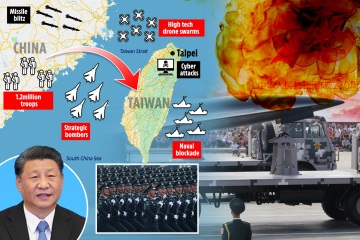[ad_1]
CHILLING AI satellite swarms that hunt down and destroy enemy targets have been unveiled by China in another terrifying step in the space race.
Chinese scientists said they could now launch hundreds of mini satellites – dubbed “cubesats” – from a large motherboard in space with deadly precision and speed.
Weighing in at 2.2lbs, these tiny satellites are so complex they can only be controlled by Artificial Intelligence (AI).
According to researchers, the complexity of a large scale space battle would be so immense that it’s beyond the human brain and even beyond some powerful algorithms, the South China Morning Post reports.
The study, published in the peer-reviewed journal Chinese Space Science and Technology, said unlocking the right AI to control the motherboard and cubesats would have “strong economic and military value”.
It comes as China alleges Elon Musk‘s SpaceX satellites came “dangerously close” to their new space station twice last year – and threatened to shoot them down.


Months later, Chinese and US satellites had a game of “geostationary orbit cat and mouse”, according to the report.
Zhang Jin, who led research into the deadly swarms, said the cubesats could be used to patrol and defend against attack from rouge forces in space using sophisticated AI algorithms that tells the drones when and how to attack.
Researchers have dubbed this the “multi-round greedy search” strategy and can instruct up to four motherboards to attack nine hostile targets in less than a day.
When put to the test, the algorithm was able instruct cubesats to destroy enemy targets in four minutes – 227 times faster than a generic algorithm which took more than three hours.
It’s also extremely efficient and can plot routes that require the least amount of fuel and energy – meaning the swarms can stay in combat for longer.
“In the future, we will add randomness to the search strategy to overcome the limitations of the greedy algorithm and obtain global optimal results,” Professor Zhang said.
It comes as Beijing claimed it has developed an anti-satellite AI system that has mastered the art of deception.
According to the Morning Post, a trial of the lethal system found AI controlled three small satellites to approach and capture a high-value target and repeated the exercise thousands of times.
China has also launched an AI drone mothership able to operate and potentially launch military attacks autonomously in a chilling world-first.
According to the Chinese, the vessel is designed for marine research but already there have been fears it could be used to launch attacks on the US Navy and other adversaries.
The Zhu Hai Yun can hit top speeds of 20 miles per hour and can reportedly carry around 50 aerial, surface, and underwater drones.
Meanwhile, experts have warned drone warfare could soon look like something out of Star Wars.
Beijing has invested heavily into drone warfare over the past decade as the regime aims to achieve its goal of military parity with the US by 2049.
Ex-marine Brendan Mulvaney told The Sun: “If we wait 10 or more years before we see a major conflict, the scope and scale of drones are going to change a lot.
“You may have effective and larger munitions coming off drones, but smaller drones could be weaponized to the point where you have this intermingling of a long-range autonomous weapon.
“We often think of aviation drones but there’s a whole suite of unmanned vehicles that bring more capability, making it more challenging for the adversaries.”
Drone expert Seth Frantzman said: “Drones will not just slam into a ship with people on board.
“Drones from the air could attack machines in the sea and we could see something that looks more like Star Wars.”
[ad_2]
Image and article originally from www.the-sun.com. Read the original article here.





